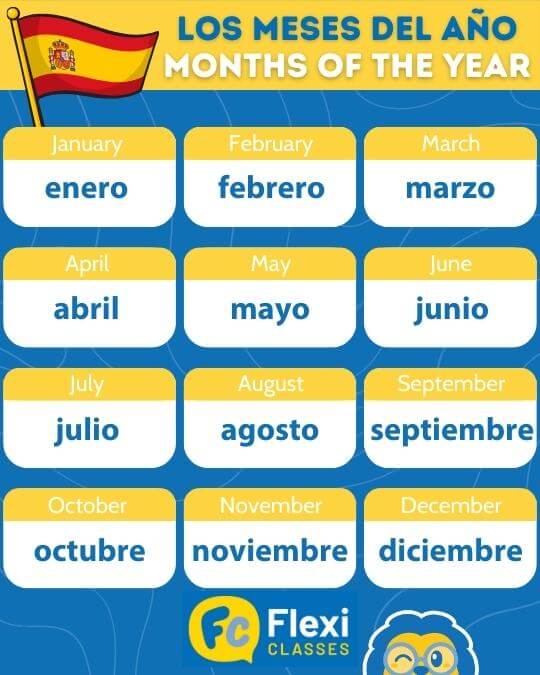How To Write the Date in Spanish - Using the Proper Format
How To Write the Date in Spanish
When To Use Digits, Words and Both!

📌 What is the date today?
This is probably one of the most frequently asked questions you will get (and ask). So let’s prepare for that eventuality in Spanish.
It will also help in things like planning activities with friends, meetings at work and of course, talking about your birthday in Spanish!
But in what order?
In this blog we’ll answer that question, teach you how to say the months in Spanish and show you the correct format when using digits and words.
How To Write the Date in Spanish || But First, the Months in Spanish
How To Write the Date in Spanish || Accepted Date Formats in Spanish
How To Write the Date in Spanish || Dates in Spanish, Digits or Words?
How To Write the Date in Spanish || Quiz
How To Write the Date in Spanish || FAQs
How To Write the Date in Spanish ||
But First, the Months in Spanish
Let’s start with the basics.
Right off the bat, know that one of the most common forms of writing the date in Spanish combines Arabic numbers for the date and the year, while the months are expressed in words.
In light of that, let’s review (or learn) how to say each of the 12 months in Spanish.
| English | Spanish |
|---|---|
| January | enero |
| February | febrero |
| March | marzo |
| April | abril |
| May | mayo |
| June | junio |
| July | julio |
| August | agosto |
| September | septiembre |
| October | octubre |
| November | noviembre |
| December | diciembre |

Some grammar tips:
Generally, when writing a month in Spanish, it is not capitalized.
However, there are a few exceptions to the rule, primarily when a month is used as a proper noun, such as when we refer to a place/location, street name, holiday, etc. and, of course, if used at the beginning of a sentence.
Some examples, such as when referring to:
Here’s the information in a table format:
| Category | Spanish | English |
|---|---|---|
| A place | Hospital Universitario 12 Octubre | 12th of October University Hospital |
| A location | Plaza del 2 de Mayo | 2nd of May Square |
| A street | Calle del 6 de Diciembre | 6th of December Street |
| A holiday | El 4 de Julio es día festivo en los Estados Unidos. | The 4th of July is a holiday in the United States. |
| Month (start of sentence) | Agosto es el mes de vacaciones en España. | August is the vacation month in Spain. |
How To Write the Date in Spanish ||
Accepted Date Formats in Spanish
[When asked ¿Qué día es hoy? (What date is it today?), know that while three different date formats are accepted in Spanish, there is only one recommended format, as established by the Real Academia Española (RAE).
Oh and if you haven’t heard of the Real Academia Española, it is the official regulatory body of the Spanish language. Humorously speaking, a sort of ‘grammar police’, meant to safeguard and ensure the uniformity of the Spanish language.
Let’s get back to writing the date in Spanish.
These are the existing formats:
The ascending format, which is the only recommended format when writing the date in Spanish, meaning, in this specific order: date + month + year, like in the examples:
24 de diciembre de 2024
24.12.2024
Notice that in the first example, between the date and the month as well as between the month and the year, the preposition de (translated as ‘of’ in this context) is necessarily intercalated.
So the actual template would look like this, although note that the connecting word de is usually omitted in English:
date + de + month + de + year, like for example: 20 de mayo de 2024.
The RAE recommends that this ascending format be used when writing the date in all Spanish-speaking countries.
US format. This alternative format, used mainly in the United States and in countries of US influence, follows a different sequence: month + date + year, as in the example: diciembre 24 de 2024.
Notice that in the example, the preposition de (‘of’ in English in this context) is omitted between the month and the date and only maintained between the date and the year.
Also, while this format is used in some Spanish-speaking Latin American countries, its use is not recommended by the RAE when writing the date in Spanish, as it is considered to be an Anglicism.
Descending format. The descending format (year + month + date) is recommended by the ISO (International Organization for Standardization) for dates written in figures, like in the examples:
2024.12.24 (in the place of 24 de diciembre de 2024)
However, according to the RAE, this format should only be used in scientific or technical documents that are intended for international distribution.]
How To Write the Date in Spanish ||
Dates in Spanish, Digits or Words?
So you may be asking, how to correctly write a date in Spanish? Is it better to use only digits or words or both?
Well, the answer is that all of the above formats (except for the ISO one, which only allows for digits), can be correctly written with (i) a combination of digits and words, (ii) words entirely or (iii) digits only.
But still, which system among the three is more commonly used? Let’s delve into each one.
Combination of words and digits:

The most commonly used system when writing the date in Spanish is the one that combines the use of both words and digits, following the ascending format (date + month + year), like in the examples:
21 de febrero de 2022 (February 21st, 2022)
10 de julio de 2019 (July 10th, 2019)
Words only
The system that exclusively uses words for writing a date in Spanish, although correct, is mostly outdated and, if ever, is currently used only when, for security reasons, the date must be unalterable, like in bank checks, public deeds or notary records.
Here is an example of a date fully written in words:
Veinte de mayo de dos mil veintidós. (Twentieth of May, two thousand twenty-two).
Digits only
For the sake of brevity, dates can be written in Spanish by the use of digits only, following the ascending format and separating each segment with either a period, a slash or a hyphen and with no blank spaces in between, like in the examples:
12.24.24
28-9-22
15/3/1921
Some recommendations to consider when using the digit only format:
(i) The year can be indicated either with the last two digits or with the complete sequence of 4 digits.
(ii) When the number corresponding to the month or date is below 10, it is best not to add a zero prior (unless it is necessary for technical or security reasons), so for example, if the date were May 9, 2010, the each of first sequences would be the better numerical representations:
5.9.2010 instead of 05.09.2010
5-9-10 instead of 05-09-10
5/9/2010 instead of 05/09/2010
(iii) Only when using the ISO descending format must the zero prior to the date never be omitted, if the date or month is below the number 10.
The correct numerical sequence with the ISO format (for technical and scientific documents meant to be circulated on an international level) would then be as follows:
05.09.2010
05-09-10
05/09/2010
Now that you’ve mastered the knowledge above, why not explore these essential resources?
👉Reflexive Pronouns in Spanish
🌍 And for a more global challenge, make sure to take a look at Days and Months in Chinese and Dates in Japanese
How To Write the Date in Spanish || Quiz
How well do you know your Spanish swear words?
Whether you knew some (or all) of them before reading this article, or on the contrary just learnt a bunch of them, take our quick fire quiz to see how well you remember them.
Share your results in the comments, and good luck!
How To Write the Date in Spanish || FAQs
How do you write the date in Spanish format?
The recommended format by the Real Academia Española (the official regulatory body of the Spanish language) when writing a date in Spanish is the ascending format, meaning, in this order: date + month + year, like in the example:
9 de octubre de 1980 or also 9.10.1980
The preposition de (translated as ‘of’ in this context) must be intercalated between the date and the month as well as between the month and the year. So the actual template would look like this: date + de + month + de + year, for example:
20 de mayo de 2024
The Real Academia Española recommends that this ascending format be used when writing the date in all Spanish-speaking countries.
What is the Spanish date format for mm/dd-yyyy?
When writing a specific date in Spanish using digits only, the correct sequence is the ascending format (date+month+year), separating each element with either a period, a slash or a hyphen and with no blank spaces in between, like in the examples:
12.24.24
28-9-22
15/3/1921
Do you capitalize the months in Spanish?
In general, when writing a month in Spanish it is not capitalized.
However, there are a few exceptions to the rule and that is when a month is used as a proper noun, such as when we refer to a place/location, street name, holiday, etc. and, of course, if used at the beginning of a sentence. Some examples:
Hospital Universitario 12 Octubre (referring to a place)
Plaza del 2 de Mayo (referring to a place)
Calle del 12 de Octubre (referring to a street).]
How do you say ‘today’s date’ in Spanish?
In answer to the question in Spanish ¿Qué día es hoy? (What date is it today?), here are the most frequently used phrases in Spanish you can use to say ‘today’s date’:
La fecha de hoy es el 17 de junio. (Today’s date is June 17th.)
Hoy es el 23 de enero. (Today is January 23rd.)
Es el 15 de septiembre. (It’s September 15th.)
Is the word order the same for dates in English and in Spanish?
When writing the date in Spanish, using either a combination of words and digits (commonly used) or exclusively with words (uncommon), the correct sequence to use is the ascending format (date + month + year).
In English, however, the date in words is written reversing the traditional Spanish ascending date and month sequence and instead is indicated like so: month + date + year. See the comparative examples below.
30 de marzo de 1998 or treinta de marzo de mil novecientos noventa y ocho
vs
March 30th, 1998 or March thirtieth, nineteen ninety-eight.
Want More From LTL?
FANCY LEARNING SPANISH? Check out our online Spanish courses here.
We offer a 7-day free trial to all online students where you can study Spanish 24/7. It doesn’t end there either.
We teach over 10 of the world’s most popular languages 😎
Come and be a part of our amazing community.











